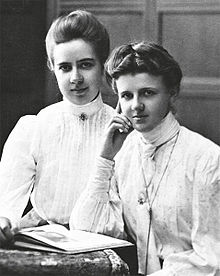Adelheid Torhorst

Adelheid Torhorst (born August 16, 1884 in Ledde , Westphalia , † December 11, 1968 in Lehnitz ) was a German educator and politician .
Life
Torhorst was born in Ledde, Westphalia, Tecklenburg (Westphalia), as the daughter of Pastor Arnold Torhorst (1841–1909) and his wife Luise, née. Smend (1847–1923) born. She had a total of six siblings, especially the relationship with her four years younger sister Marie Torhorst (1888-1989) was very close. Both of them influenced each other in their educational policy thinking and acting throughout their lives.
From 1896 to 1901 Adelheid attended a secondary school for girls (Lyceum) . She then began training as a teacher in the Oberlyzeum in Keppel Abbey , which she completed in 1904 with the recognition of her teaching qualification for secondary schools and high schools for girls. From 1905 to 1907 she worked as a house educator in Mecklenburg , 1908/1909 as a teacher at the higher private girls' school in Wittenberg . After her father's death in 1909 and the family moved to Bonn , she worked as a teacher and prepared for her own Abitur , which she passed at Easter 1910 as an “external” at the Königliche Realgymnasium in Trier . In the same year she began studying pure and applied mathematics in Bonn.
There should be from 1913 and her sister Marie in the same subject enroll . As "second generation students", Adelheid and Marie Torhorst were exceptions among the students. The chosen subject, mathematics, was quite popular among women of this generation. Their choice was probably favored by the fact that Prussia had introduced mathematical and natural science lessons at the higher girls' schools. Thus, despite the mandatory dismissal of a civil servant in the event of her marriage ("civil servant celibacy"), a job as a mathematics teacher seemed attractive for planning an independent professional life. In addition, the doctorate, completed in 1915 with Eduard Study as a doctoral supervisor , entitled The Rational Normal Surface of the Fourth Order of the R5 and its Projections in Four- and Three-Dimensional Space , confirms her fascination with mathematics. The fact that she also successfully completed a second degree in German studies in Bonn in 1918 after completing her employability as a senior teacher at secondary schools, suggests hard work and diverse interests. In the years 1918-1921 she worked as a school teacher at the Municipal educational establishment with Lyceum ( Victoria School ) in food business.
The First World War (1914–1918) represented a significant turning point for them - as for all contemporaries who had to endure misery, hardship, despair, loss and grief. Shaped by these experiences, Adelheid Torhorst joined the USPD one year after the end of the war a. In 1922 - six years before her sister Marie - she switched to the SPD , of which she remained a member until 1931. From 1924 to 1931 she was a member, from 1927 secretary for the Federation of Free School Societies in Germany (Unterverband District Düsseldorf). As part of this office, she took part in the meeting of the Federation of Free School Societies in Germany in Magdeburg, which took place on the basic topic of “Sociology and School”. In addition, in 1929 she was a delegate to the Reichstag of the Federation of Free School Societies in Braunschweig and an SPD delegate to the SPD party congress in Magdeburg. In those creative years her struggle for the secularity of school and teaching repeatedly hit the boundaries of her own party. This can be seen, for example, in the controversy with the Berlin SPD city council and Reichstag member Kurt Löwenstein . On September 1, 1931, Adelheid Torhorst publicly converted from the SPD to the KPD .
Like many of her political companions, Adelheid had to emigrate abroad (the Netherlands ) when the National Socialists came to power in January 1933 . The twelve-year phase of the Nazi dictatorship (1933–1945) meant for her an existence in the underground.
After the end of the Nazi dictatorship and the Second World War (1939–1945), she moved to Weimar in April 1949 to live with her sister Marie . Together they moved to Lehnitz in the Oranienburg district in 1951 . From 1961 she worked on personal memories and analyzes of the secular school movement and the Federation of Free School Societies in the Weimar Republic , which, however, were only published after her death (1968).
Honors
The Torhorst Comprehensive School in Oranienburg is named after Adelheid and Marie Torhorst.
Works
- The rational normal surface of the fourth order of the R5 and its projections into four- and three-dimensional space . Dissertation, Tübingen 1915.
- On the secular school movement in the Weimar Republic. Personal memories and analysis . Edited by Karl-Heinz Günther, Academy of Pedagogical Sciences of the GDR, Berlin 1972.
literature
- Torhorst, Adelheid In: Werner Röder, Herbert A. Strauss : Biographical manual of German-speaking emigration after 1933 . Volume 1, Saur, Munich 1980, p. 174.
- Karl-Heinz Günther (Ed.): Pastor's daughter, educator, communist . From the life of the sisters Adelheid and Marie Torhorst. Dietz, Berlin 1986.
Web links
- Literature by and about Adelheid Torhorst in the catalog of the German National Library
Individual evidence
- ↑ Arnold Torhorst takes over school sponsorship for Oranienburger Torhorstschule. In: Märkische Oderzeitung . Retrieved May 26, 2014.
| personal data | |
|---|---|
| SURNAME | Torhorst, Adelheid |
| BRIEF DESCRIPTION | German politician |
| DATE OF BIRTH | August 16, 1884 |
| PLACE OF BIRTH | Ledde , Westphalia |
| DATE OF DEATH | December 11, 1968 |
| Place of death | Lehnitz |